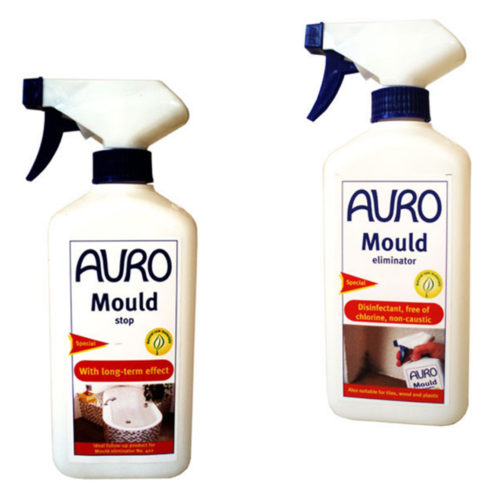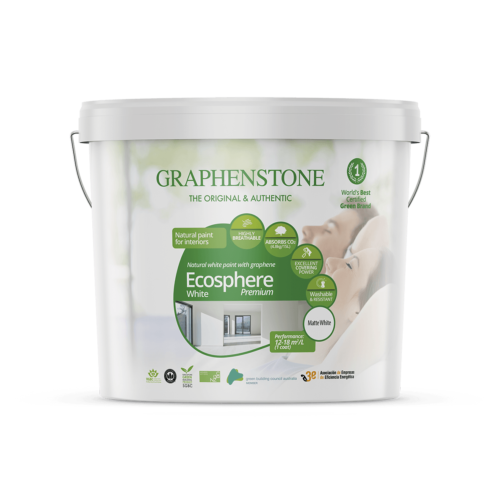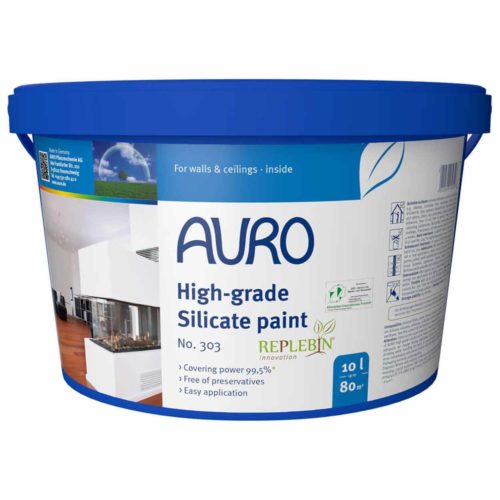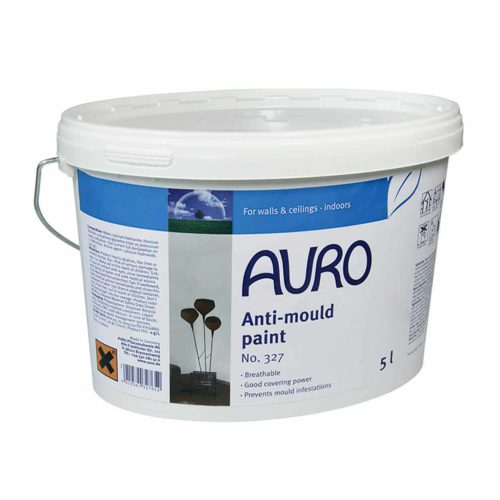Natural Anti Mould Paints & Mould Cleaning Solutions
We have a good selection of some of the best non toxic, eco friendly and natural anti mould paints and mildew resistant paint available to buy in the UK. These are well known and well respected products that work extremely well, but at the same time being non toxic and not environmentally damaging.
We advise Lime based paints for naturally anti mould properties, such as the natural wall paint Graphenstone ecosphere.
Easy to apply, eco friendly and non toxic natural mould paint.
Safe & Secure: You can buy from us assured you are using a super secure checkout and at some of the cheapest prices online, not forgetting that we offer Next Day Delivery too!
Use one of these natural amazing anti-mould paints, to keep your home’s healthy glow alive. Their anti-mould paints are the perfect shields against mildew. These revered products come in a wide variety of types, and they’re friendly towards our environment.
These anti-mould products are free from dangerous toxins, making your job that much easier. With products like these, you have a hardcore army that’ll shield your walls from the dangers of mould. These products are safe to breathe around, and have been tested for its safety.
Rest assured; you’ll be using only the best products with the most amazing protection. These products come in easy to use containers, making home renovation effortless. These products can be used alongside each other, creating the perfect anti-mould army. They are an incredible alternative to your everyday paint, filled with raw materials, great protection against mould and a powerful finish.
Common Anti Mould Paint Questions!
- Is there a child friendly anti fungal wall paint?
- What is anti mould paint?
- What type of mould that anti mould paint fights against?
- How do you use Anti-mould Paint?
- Here is how you use anti-mould paint
- How does anti mould paint work?
- Are lime paints anti mould paints?
- How should anti mould Lime wash paint be applied?
- Can I use vinegar for mould removal?
- What kind of vinegar should I use for removing mould?
- How do I use vinegar to fill mould?
- What are other natural ways to remove mould?
- Removing mould with Tea tree oil solution
- Removing mould with Citrus seed extract
- Removing mould with Hydrogen peroxide
Is there a child friendly anti fungal wall paint?
Are you in search of a child friendly anti fungal wall paint in the UK? You’re not alone! Mould is a microscopic fungus that has many dangerous side effects on humans including respiratory distress, allergies, sore throats and more. As with many things, these effects can be more pronounced in young children as well as pregnant or nursing women. So the first step would be to find a mould inhibiting paint for your children’s room. Getting rid of mould and fungus goes a long way towards ensuring the health of your family. However, traditional anti fungal wall paints are as dangerous as mould—many of the ill effects it can cause are the same as those you’d experience with mould exposure. So unfortunately an anti-mould wall paint alone isn’t going to solve all of your problems.
Much of England has damp conditions year-round, so mould is definitely a bigger concern. That means it is even more important to find a child friendly anti fungal wall paint in the UK. That brings us to the second half of the concern—finding such a paint that is safe for use in nurseries and toddler rooms. VOCs (Volatile Organic Compounds) that are found in traditional paints are toxic and should be avoided at all costs. Thankfully there is a safe alternative that will have your walls looking beautiful, your children healthy, and your mould and fungus growths under control: Graphenstone, a wonderful company that manufactures natural and organic paints and products that are ideal for situations such as these. Their natural anti-mould paints are perfectly safe for use around your family and pets.
Once the mould or mildew growth is under control, you’ll be ready to put down some eco-friendly paint.
There are even options that can reduce odours in the air in addition to preventing mildew and mould from taking hold such as natural clean air emulsion paint. So don’t fret, there are wonderful child friendly anti fungal wall paint options in the UK, and everywhere else for that matter! Check out the full line of child friendly products here. Buy child friendly anti fungal wall paint in the UK here.
What is anti mould paint?
We have all experienced moulds growing in our homes. They can grow anywhere and have the ability to turn prized possessions into dusty relics that are fit for garbage. Since mould can be a common problem in damp and warm environments, it becomes important to prevent it. For this purpose, there are numerous solutions available, the best one being anti mould paint which is not only aesthetically pleasing but also non-toxic and environmentally friendly. In this article, we discuss different methods to get rid of mould in your homes.
What type of mould that anti mould paint fights against?
Moulds are a type of fungus that grows both indoors and outdoors. It can take a variety of forms and textures depending on the surface. It appears as a discolouration or stain on the surface. mould can have a fuzzy, velvety or rough appearance depending upon the surface on which it is growing.
Mould grows in damp and warm environments such as the leaks in roofs, windows and pipes. It also grows on walls if there is accumulation of moisture there for extended periods of time. moulds produce spores which spread through air or by the means of other carriers. These mould spores can persist in conditions where mould wouldn’t survive itself so there is no way to stop the spread of these spores.
Mould can cause a variety of health problems to people who have allergies, respiratory issues like asthma or already weakened immune systems. It can cause redness and itchiness in the eyes, runny nose, itchy throat, sneezing etc. People who are asthmatic can have a severe asthmatic attack triggered because of moulds. Similarly, people with weakened immune systems can experience respiratory diseases like bronchitis and pneumonia etc.
How do you use Anti-mould Paint?
One of the best ways to get rid of moulds is by using anti-mould paints. Anti-mould paints don’t wipe out or clean the already existing mould rather it prevents the growth of mould on the surface where it is applied. Today we have a range of Anti-mould paints which are environmentally friendly and non-toxic yet aesthetically pleasing at the same time. So you can apply the paint without the risk of harming your family or your loved ones and protect your walls from mould, mildews and other forms of fungal infestations.
Here is how you use anti-mould paint
- Start with a mould free wall.
- Clean the dirt and debris with a wet cloth, then allow it to dry thoroughly.
- First apply a mould resistant primer. It is important to get into the corners meeting the wall where the ceiling meets the wall because that is where the mould normally grows. Allow it to dry for at least 24 hours.
- Apply the anti-mould paint and allow it to dry for 24 hours before the application of the second layer.
- Make sure that you do not use the room until the paint and the primer have completely dried.
How does anti mould paint work?
The way an anti-mould paint works is simple. It contains the legally allowed amount of fungicides and mildewcides. These antimicrobial ingredients help prevent the growth and spread of moulds once it is applied to the desired surface.
Mould resistant paints ought to be used at those places where there is excessive moisture in the air, or that space is exposed to significant levels of moisture and or if that place is damp. This includes your bathrooms (where steam from shower can contribute to the development of moulds) or the kitchen (water used for cooking and steam from pressure cookers etc.) and places like basements which often get a bit damp.
The most important piece of information to be kept in mind is that mould resistant paints should only be applied to mould-free surfaces. If a surface has mould growing on it, then application of paint will prevent further growth of mould but before applying paint, make sure to remove all traces of mould and allow the surface to dry completely. mould resistant paint won’t stop the mould from growing inside and it will only make the problem worse in the end. Keeping that in mind, it is also not a guarantee that mould would never grow there, especially if there is significant flooding or water damage.
Are lime paints anti mould paints?
The best solution to moulds are lime based paints as they have a naturally high PH level, so can offer protection without added chemicals and fungicides.. These paints are made by crushing limestone and adding it to water to make putty. The putty is then aged and water and natural pigments are further added to it to make the lime paint.
Made from natural limestone and natural pigments, lime paints are at the top of environmental friendly paints. These paints are solvent free and sometimes contain additives to keep their environmental friendly attributes intact. Lime paints have the ability to absorb Carbon dioxide as well, Ecosphere paints absorb 4.8 kg of carbon dioxide per 15 litres.
Lime has a high level of pH at which micro-organisms cannot survive which adds a hypoallergenic quality. This means that moulds, mildews and any form of fungi cannot grow. Hence lime paints offer best protection against moulds. Lime paint can be used indoors and outdoors, unlike most paints, lime paints sink into the surface so they can be used on porous surfaces plaster, stone and brick.
How should anti mould Lime wash paint be applied?
- Start with a mould free wall.
- Clean the surface from dirt and debris and make sure that it has no moulds growing on it.
- Apply lime paint to the surface in several coats using a long-haired or masonry paintbrush that creates feathered strokes.
- Let the paint dry and do not use the room until it has dried completely.
Can I use vinegar for mould removal?
When we talk about home remedies for the removal of moulds, vinegar may just stand out as the best possible solution. Vinegar is better than bleach when it comes to a mould removing agent. The mild acid in vinegar removes almost 82% of the known types of moulds and can also prevent future mould outbreak.
Bleach is not an effective mould killing agent. In fact, it just kills the mould on the surface and not the membrane underneath it which leads to potential outbreaks in the future. Moreover, recognising bleach as a “threat”, the mould will grow back even stronger than before. Similarly, in case of porous surfaces mould membrane will move further into the surface to avoid the chemical.
What kind of vinegar should I use for removing mould?
For the purpose of mould removal, no special kind of vinegar is required. For this purpose, regular white distilled vinegar with 5% acidity is generally used. You can also use the “cleaning vinegar” with 6% acidity.
How do I use vinegar to fill mould?
To effectively clean the surface from mould infestation, following method should be adopted:
- Wear protective gear like gloves, masks and safety goggles to prevent yourself from direct exposure to mould.
- Add the cleaning vinegar to a spray bottle and spray it on the desired area.
- Let it sit there for an hour before wiping away mould.
- If follow up cleaning is required then combine a teaspoon of baking soda with two cups of water. Pour it into a spray bottle and then scrub the area properly.
- Rinse it with water, spray vinegar again and let it dry.
Even though vinegar is very effective as a mould removal agent, it can damage some surfaces because of its acidity. Hence it is not recommended to be used on natural stone, waxed wood, cast iron or aluminium.
What are other natural ways to remove mould?
In addition to vinegar, there are several other natural remedies for removal of moulds. These ingredients are easily available at home and can be accessed.
Removing mould with Tea tree oil solution
Tea tree oil is an effective mould removal remedy but it is slightly more expensive than other natural remedies. Two teaspoons of tea tree oil mixed with two cups of water can be very beneficial. Just spray it onto the desired surface but do not rinse. It has a strong smell which dissipates within a few days.
Removing mould with Citrus seed extract
Unlike vinegar, citrus extract does not have any odour and is an extremely effective remedy. For usage, dilute about 20 drops of citrus seed extract with 2 cups of water, mix it in a spray bottle and spray on the infested area but do not rinse.
Removing mould with Hydrogen peroxide
To use this remedy, spray 3% percent hydrogen peroxide from the bottle onto the desired area and leave it for 10 minutes. Scrub clean and then wipe with a damp cloth to remove residual mould spores. Hydrogen peroxide can also be used with vinegar but the mixture should be stored in a dark place.
These are the different methods that can be used to get rid of moulds but most importantly with the development in the paint industry, the anti-mould paints provide a long term solution to mould and other fungal infestations in homes.





